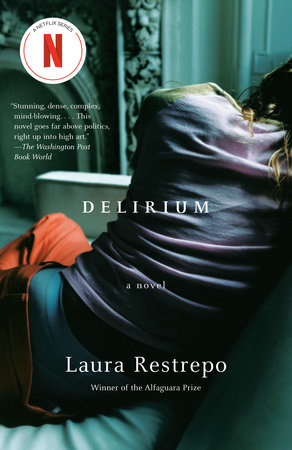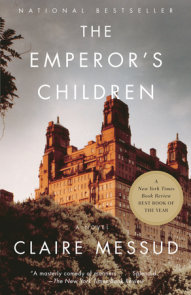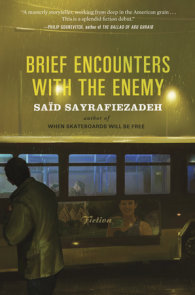READERS GUIDE
“Stunning, dense, complex, mind-blowing. . . . This novel goes far above politics, right up into high art.”—The Washington Post Book World
The introduction, discussion questions, and suggestions for further reading that follow are intended to enhance your group’s discussion of Delirium, a haunting, revelatory story of a young woman’s decline into madness. Set in Colombia during the 1980s, it traces the interlocking lives of the upper and criminal classes against the turmoil of a country held in thrall by the notorious drug lord Pablo Escobar.
Introduction
Aguilar, a literature professor reduced to selling dog food after losing his job at the university, returns from a short trip to find his wife, Agustina, transformed into “someone terrified and terrifying, a being I barely recognized” [p. 1]. The daughter of a well-to-do family who delights in breaking the rules and flaunting her eccentricities, Agustina Londoño was found cowering in a hotel room; the manager reported that an unidentified man left her there the previous evening. Searching for an explanation for Agustina’s breakdown, Aguilar pieces together his own recollections, speculations based on Agustina’s vague stories about her past and bits of family history revealed by Agustina’s aunt, Sofi, who has arrived to help care for her.As the novel unfolds, other stories intersect with Aguilar’s narrative. We hear from Agustina herself, in tangled tales that conflate past and present, memory and fantasy. Midas McAlister, Agustina’s former lover and a money launderer for Escobar, paints a wry and telling portrait of Colombia’s corrupt society—and of the corruption in the heart of the Londoño family. Glimpses into the life of Agustina’s grandfather, Nicholas Portulinus, a talented and eccentric musician and composer, hint at a family history of madness.
Questions and Topics for Discussion
1. The multiple narratives in Delirium are presented without transition. Discuss the elements—for example, the use of recurring images both actual and metaphorical—that connect one section to the next.
2. How would you describe the tone and style of the various threads of the novel? What does Aguilar’s account demonstrate about the way he thinks and looks at the world? Are Agustina’s monologues simply the ramblings of an unbalanced woman or do they reveal something about her character, intelligence, and perceptiveness? What stylistic oddities bring out her state of mind and self-awareness? What effect does Midas’s slangy language and casual, conversational style have on his credibility as a narrator? How would you compare Aguilar and Midas in terms of their reliability and the sympathy they evoke in readers? What literary qualities distinguish the vignettes about Nicholas and Blanca from the other narratives? Are they as powerful and engaging as the other stories?
3. In what ways do Aguilar’s and Sofi’s reactions to Agustina’s behavior differ? What principles (or beliefs) shape their responses? What roles do their personal histories with Agustina play in the way they interpret her rages and compulsive rituals?
4. Aguilar says, “I never bothered to ask [Agustina] about her past, her family, or her memories. . . . I mourn the questions I didn’t ask” [p. 21]. Do you think that Agustina would have been open with him about the negative sides of her upbringing or would her own confusion and guilt have made that impossible? What insights does Aguilar’s list of the faults her family finds with him provide into why he and Agustina were attracted to one another? To what extent did each of them act out of willfulness and self-interest?
5. How does Agustina see her father? Does her portrait of him change as the novel progresses? In what ways is their relationship shaped by the dynamics in the household, the family’s status, and traditional Latin American culture? Are there moments or incidents that capture familiar experiences? Discuss, for example, what their ritual of locking their doors together [pp. 75-6] and their interactions when Agustina begins dating [pp. 192-8] illustrate about the nature and complexities of many father-daughter relationships.
6. What do Agustina’s efforts to protect Bichi show about her inner conflicts? What is the significance of the juxtaposition of religious and sexual elements in the secret ceremonies they conduct [p. 33]?
7. Eugenia is presented from various perspectives, from Aguilar’s view of her as a cold, uncaring mother [pp. 22-4] to Agustina’s memory of watching her prepare for an evening out [pp. 97-100], to Sofi’s description of her sister’s isolation within the family [p. 108]. How do the personalities, needs, and prejudices of each influence their impressions of her? In a society built on the unquestioned authority of men, could Eugenia have played a larger, more effective role in the family? Could she have prevented his brutal treatment of Bichi or at least mitigated the effects of his blatant preference for the macho Joaco? What does her reaction to Agustina’s first period [pp. 151-2], and especially to the confrontation that ultimately tears the family apart [p. 300], reveal about her own sexuality and the repression of upper-class women in Colombia? Does the exposure of lies and deceptions the family harbors change your opinion of Eugenia?
8. Class and money are central to the plot of Delirium, as well as the interactions among the characters. How does Midas capture this, both in his dealings with Escobar, Spider, and the other thugs, and in his behavior with and observations about the Londoño family? Why is he better able to see the importance of both class and money than the other characters? Do you think he expresses the author’s point of view on the underlying economic and social causes of Colombia’s corruption and the violence that has become commonplace?
9. In his description of life with Agustina, Aguilar says, “Madness is a compendium of unpleasant things: for example it’s pedantic, it’s hateful, and it’s torturous” [p. 105], and Midas, addressing the absent Agustina, complains, “You start to use fancy words and predict things like a prophet, but a whiny, annoying prophet . . .” [p. 254]. How do you think Agustina would respond to these characterizations? What aspects of their descriptions come out either explicitly or implicitly in her own accounts? Do her memories and fantasies offer a more profound and perhaps more realistic portrait of madness and the consequences, real or imagined, of being a “visionary”?
10. Why does the story of Nicholas and Blanca add to the novel? What insights does it provide to the nature and causes of madness? Are there parallels between the emotional confusion (about love, sex, and belonging, for example) Nicholas and Agustina experience? Are there similarities between Blanca and Aguilar and the roles they play in their spouses’ lives?
11. Aguilar describes Colombia as “a country . . . split from top to bottom by a mountain range, the highways . . . twist and twine around abysses . . . and they’re seized every day by the army, the paramilitaries, or the guerillas, who kidnap you, kill you, or assault you with grenades . . .” [p. 29]. How do the images this passage invokes relate to Agustina’s breakdown? In what ways does Colombia’s decline into chaos and fear parallel the delirium Agustina suffers from?
12. Although Escobar was killed in 1993, the drug trade continues to thrive in Colombia. What does Delirium demonstrate about the power of drug-traffickers and the failures of America’s “war on drugs”?
13. The epigraph of the novel quotes Gore Vidal: “Wise Henry James had always warned writers against the use of a mad person as central to a narrative on the ground that as he was not morally responsible, there was no true tale to tell.” Does Delirium belie James’s wisdom? Can you think of other novels in which a mentally ill or disturbed person plays a central role and exposes the deceptions and the immorality within a family or a society? Are the situations in which these lies are necessary to the survival of an individual or even an entire nation?






















